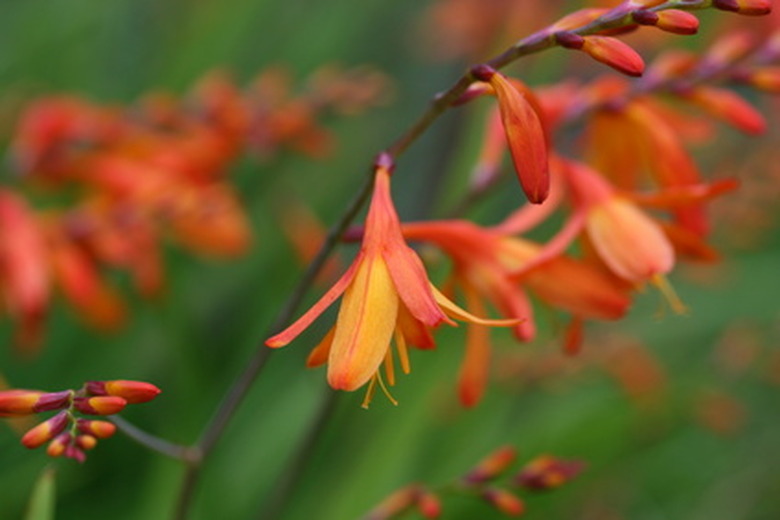Crocosmias
Step 1
Crocosmia Lucifer is an easy to grow perennial with sharp leaves, similar to the day lily, and bright red flowers that will heat up any garden. Hardy from zones 5 to 9, Crocosmia Lucifer can be grown in a variety of climates, as long as they lack a winter with temperatures under -20 degrees Fahrenheit. With a height of 3 to 4 feet, these flowers will surely make a statement when they bloom.
Step 2
Step 1
Choose a spot to plant your Crocosmia Lucifer. They need full sun, but will tolerate a number of soil types, from sandy to clay, acidic to alkaline.
Step 2
Plant your Crocosmia Lucifer in the early spring. Dig one hole for each bulb, about 3 to 4 inches deep and 2 inches in diameter. Space each hole about 1 to 2 feet apart. Place the bulbs in the holes and cover with soil. Pat down firmly.
- Crocosmia Lucifer is an easy to grow perennial with sharp leaves, similar to the day lily, and bright red flowers that will heat up any garden.
Step 3
Water your Crocosmia Lucifer regularly, about twice a week for five minutes each watering.
Step 4
Divide your Crocosmia Lucifer after 2 years, when it begins to crowd itself. Replant at a depth of 4 to 5 inches.
Step 5
Place mulch over the Crocosmia Lucifer in the winter to protect it from killing frosts.
Step 6
Fertilize the soil around the Crocosmia Lucifer in the spring with compost or manure.
Crocosmia aurea, an iris family plant native to South Africa, has several edible uses. Its orange flowers produce edible yellow dye for coloring foods. East Africans treat malaria with a beverage made from its leaf sap and corms, and a rheumatism-treating drink from its roots.
- Water your Crocosmia Lucifer regularly, about twice a week for five minutes each watering.
- Fertilize the soil around the Crocosmia Lucifer in the spring with compost or manure.
Step 1
Prepare a soil bed for your crocosmia corms that is well tilled to a depth of 6 inches to allow easy root penetration into the soil. Amend the soil with compost to make it nutrient rich and aid in drainage.
Step 2
Bury your corms lengthwise in the soil, two inches deep with the eyes up. Plant multiple corms 8 to 10 inches apart to allow the corms plenty of space to naturalize and multiply over several seasons.
Step 3
Water your corms when you plant them, and then water only periodically until green shoots begin to appear in early spring. At that point begin regular irrigation to keep the soil consistently moist but not overly wet. Mulch over the plantings with an organic material such as cocoa hulls or shredded bark to prevent moisture loss to evaporation and keep down weeds.
- Prepare a soil bed for your crocosmia corms that is well tilled to a depth of 6 inches to allow easy root penetration into the soil.
Step 4
Feed your crocosmia with a good quality granular flowering bulb fertilizer in early to mid-spring after growth has appeared above the soil and once again in the summer. Follow the dosing directions on the package and apply over pre-moistened soil to prevent burn and speed nutrient uptake.
Step 1
Fill the seed tray with seed starting mix to within 1/4 inch of the rim. Water the soil until the water drips from the bottom of the tray. Allow the soil to drain completely.
Step 2
Push the seeds 1/4 inch into the soil and barely cover with soil. Crocosmia seeds require light to germinate.
- Feed your crocosmia with a good quality granular flowering bulb fertilizer in early to mid-spring after growth has appeared above the soil and once again in the summer.
- Fill the seed tray with seed starting mix to within 1/4 inch of the rim.
Step 3
Place the seed tray in an area that receives lots of light, but out of direct sunlight, and remains 68 to 70 degrees F. Keep the soil moist, not soggy, by misting it with a plant-misting bottle. The crocosmia seeds should germinate in two to four weeks.
Step 4
Transplant the seedlings outdoors, in a sunny area, in late spring when temperatures are consistently above 65 degrees F.
